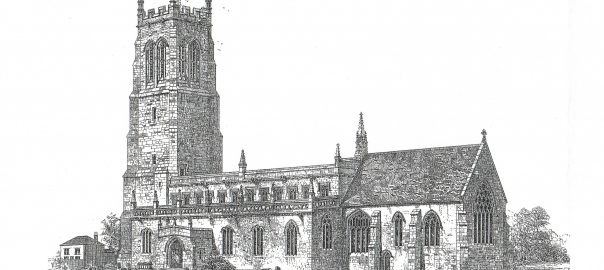St George’s is popularly known as ‘The Cathedral of the Feldon’ (the Feldon being the ‘field-land’ south of the River Avon). It can reasonably claim to be one of the grandest and most beautiful churches in the area. Its size reflects the mediaeval prosperity of Brailes which was probably the third largest town in Warwickshire, at a time when Birmingham was just a hamlet.
A few stones indicate the presence of a late Saxon or early Norman church, and the earliest part of the present church dates from the twelfth century. The first recorded incumbent, in 1120, was a priest named Thomas. Since then there have been 55 incumbents; Revd George Heighton currently holds the post.
Most of what we now know as St George’s was built between 1325 and 1375 in the decorated style which gives it its graceful proportions and light, airy atmosphere. There is some evidence that building was interrupted by the Black Death in 1349 and another plague in 1360. The varied carvings which support the roof trusses, the pattern-book font and the magnificent east window, with its five trefoiled lights and net tracery, also date from the fourteenth century.
During the fifteenth century the 120ft (40m) west tower was added. It is an important local landmark and a Christian beacon. It houses a clock, a carillon and six bells. The clock mechanism can be dated fairly accurately at 1710; it was in working order until 1957 when it was replaced by an electric movement. The carillon mechanism (which plays hymn tunes four times a day) is of the same date and is now electrically driven. The bells are the second heaviest peal of six bells in the world. The largest, the tenor bell, weighs nearly 1.5 tons! Between 1953 and 1956, Canon Kemp arranged for the bells to be removed from the tower, refurbished and reinstalled.
The Parish Registers begin in 1570 and apart from a few defective pages are complete to the present day. They are kept by the Warwickshire County Records Office.
Royalist troops were quartered in Brailes in 1643 and it’s likely that St George’s suffered considerable damage during the Civil War. Much of the extensive restoration undertaken in 1649 was replaced in the restoration of the 1870s. It was in this latter period that the three-decker pulpit and box pews were removed and the current seating installed. The ancient plasterwork was stripped away, revealing the honey-coloured stone beneath, and Victorian stained glass was added to the east window. ‘An ugly gallery painted black and with a partition of lath and plaster’ which blocked the western arch of the tower was removed at this time and, as was the fashion in those days, an organ installed in the chancel. It was completely overhauled in 1996 and again in 2001.
The heating system was installed in 1879. Originally coal-fired but now fuelled by oil, it is a good example of Victorian engineering, which has given over 130 years of service.
Vestments are worn at St George’s and the altar frontals are changed according to the liturgical season. Two beautiful frontals have been made by a member of the church – the millennium frontal is on the high altar for much of the year and the festal frontal is used for major festivals.
On the screen beneath the tower hangs the tapestry, dedicated on St George’s Day in 1990 after three years of work by members of the WI. The squares of which it is composed depict village organisations, buildings, views and hobbies. It is a vivid illustration of the positive way in which village and church life interact.
At the back of the church there is a matchstick model of
St George’s constructed from 250,000 matchsticks. It was completed in 1979 and displayed in St George’s through the generosity of its maker – Mr Fred Hall of Shipston on Stour.
At the end of the path through the churchyard is a brick building known as the Free School. This offers a small meeting room for church and community use and includes a kitchen and toilets.
Address: St George’s Church, High Street, Lower Brailes, Warwickshire, OX15 5HT
